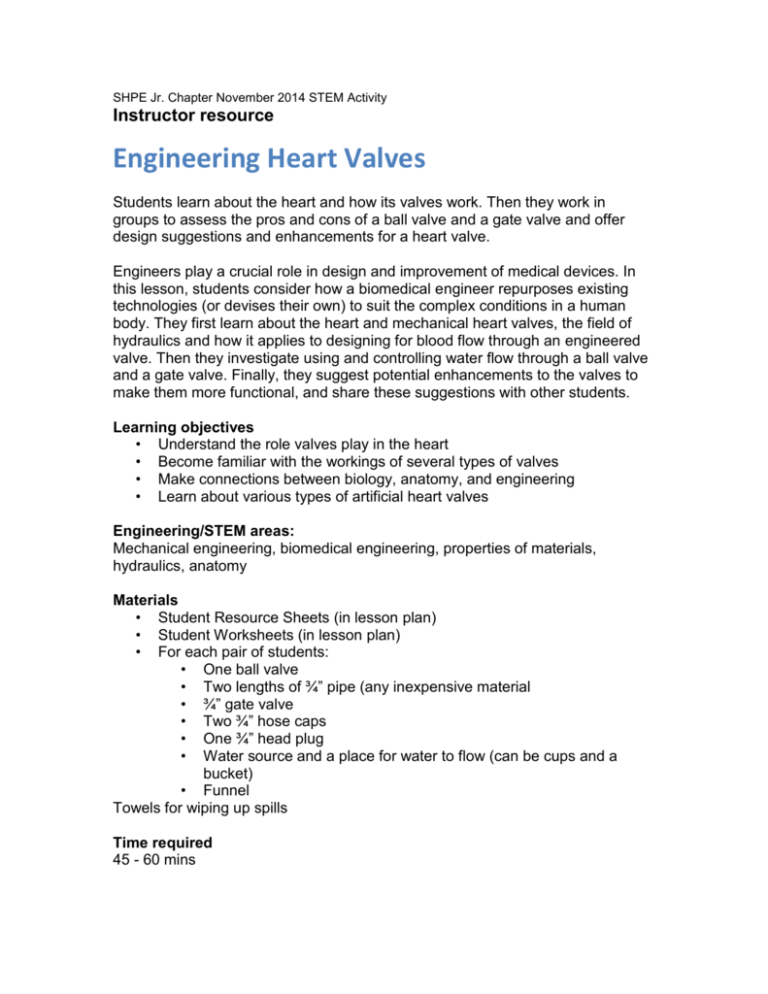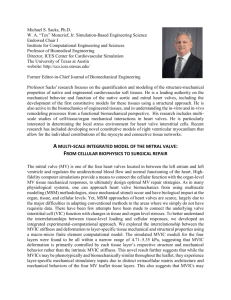Engineering Heart Valves
advertisement

SHPE Jr. Chapter November 2014 STEM Activity Instructor resource Engineering Heart Valves Students learn about the heart and how its valves work. Then they work in groups to assess the pros and cons of a ball valve and a gate valve and offer design suggestions and enhancements for a heart valve. Engineers play a crucial role in design and improvement of medical devices. In this lesson, students consider how a biomedical engineer repurposes existing technologies (or devises their own) to suit the complex conditions in a human body. They first learn about the heart and mechanical heart valves, the field of hydraulics and how it applies to designing for blood flow through an engineered valve. Then they investigate using and controlling water flow through a ball valve and a gate valve. Finally, they suggest potential enhancements to the valves to make them more functional, and share these suggestions with other students. Learning objectives • Understand the role valves play in the heart • Become familiar with the workings of several types of valves • Make connections between biology, anatomy, and engineering • Learn about various types of artificial heart valves Engineering/STEM areas: Mechanical engineering, biomedical engineering, properties of materials, hydraulics, anatomy Materials • Student Resource Sheets (in lesson plan) • Student Worksheets (in lesson plan) • For each pair of students: • One ball valve • Two lengths of ¾” pipe (any inexpensive material • ¾” gate valve • Two ¾” hose caps • One ¾” head plug • Water source and a place for water to flow (can be cups and a bucket) • Funnel Towels for wiping up spills Time required 45 - 60 mins Suggested group size: 3-4 Preparation 1. Read through both the student and instructor resources so you have the background information 2. Gather all the necessary materials. Assemble sets of materials for each group 3. Make enough copies of the Student Resource so that each student has one 4. Make one copy of the Student Worksheet per group, plus a few extras 5. Make your own set of valves and plan to demonstrate them Procedure 1. Introduce the lesson by asking if students know anyone who has had a heart valve replacement 2. Explain that valves are very important in the heart because they keep the blood flowing in one direction. Ask students what roles they think an engineer might have in developing a heart valve. 3. Distribute the student resource and go over the information in it with students. Make sure they understand a. The importance of a one-way valve in the heart b. The differences in how the three types of mechanical heart valves control fluid flow. 4. Explain that students will put together and examine two different types of valves (a ball valve and a gate valve), and experimenting with how each controls fluid flow. Tell them to imagine how they would use what they see in an mechanical heart valve. 5. Group students in teams of 3-4 and distribute the valves and other materials to each group. Make sure each group has a student worksheet and chooses a person to record the group’s answers. 6. Give groups about 25 minutes to assemble their valves and fill out their student worksheets. Circulate among students and be available for questions. 7. When you have about 10 minutes left, ask groups to share their ideas for how they might improve on a current mechanical heart valve, considering their investigations of valves. They can include a sketch, or just describe suggestions. Vocabulary Valve - device that regulates the flow of fluids by opening, closing, or partially obstructing passageways Hydraulics – a branch of engineering that’s concerned with the mechanical properties of fluids Ball valve – a valve that uses a ball, sometimes with a hole in the middle of it, to regulate fluid flow. A ball valve can make subtle adjustments in fluid flow. Tilting disc valve – a type of mechanical heart valve that contains a disc that tilts to allow blood to flow through in one direction, and closes the valve when the blood flows back the other direction. Gate valve – a valve that opens by moving a wedge out of the path of fluid flow. Bileaflet valve – a type of mechanical heart valve similar to a tilting disc valve, but which employs two semicircular leaflets that pivot on hinges, allowing for one-way flow. Assessment: Engineering Improvements • • • Have student groups describe what they noticed as they experimented with the two types of valves Ask them to explain one challenge that a current mechanical heart valve poses and an approach to solving it. Give groups feedback on their ideas and ask questions such as: • What are some important aspects to consider including in a mechanical heart valve? You might encourage them to also consider how easily the valve might be implanted and/or manufactured. • What properties would you want the valve materials to have and why? • What sort of engineering knowledge and experience is important to designing a medical device like this one? Extensions - Have students design and test heart valves they make from everyday materials. Use these activities as inspiration: o http://amascience.wikispaces.com/file/view/G104+Designing+Artificial+Heart+ Valves.pdf - o http://www.coe.utah.edu/wp-content/uploads/pdf/k12/2AArtificial%20Heart%20Valve%20Lesson%20Plan.pdf o https://www.teachengineering.org/view_activity.php?url=collection/c ub_/activities/cub_heartvalves/cub_heartvalves_lesson01_activity1. xml Tell students to read about heart valves engineered from tissue and write a paper or give a report. There are many new advancements in this field, so you could take many directions with this. o http://www.nature.com/nrcardio/journal/v2/n2/full/ncpcardio0112.ht ml o http://www.wakehealth.edu/Research/WFIRM/Research/Engineerin g-A-Heart-Valve.htm o https://www.asme.org/engineeringtopics/articles/bioengineering/creating-valve-tissue-using-3dbioprinting o http://www.jmu.edu/stories/2014/heart-valve-research.shtml o http://www.iihr.uiowa.edu/research/biofluids/fluid-dynamics-ofartificial-heart-valves/ Resources/Bibliography Lesson: Engineering the Heart https://www.teachengineering.org/view_lesson.php?url=collection/cub_/lessons/c ub_heartvalves/cub_heartvalves_lesson01.xml Artificial Heart Valves http://www.coe.utah.edu/lesson_plans The Heart of the Matter http://tryengineering.org/lesson-plans/heart-matter Model Heart Valves https://www.teachengineering.org/view_activity.php?url=collection/van_/activities/ van_heartvalves/van_heartvalves_lesson02_activity1.xml Nov 2014 SHPE Jr. Chapter STEM Activity Student Resource Engineering Heart Valves Valves in the heart The human heart contains four valves—one at the base of each of the large arteries that carry blood away from the heart, and one on each side of the heart, separating the two chambers. These are all one-way valves, and their function is to keep the flow of blood through the heart moving in one direction, which is vital to maintaining circulation. Heart attacks, high blood pressure, infections, and alcohol abuse can damage valve tissue. When that Happens, the valves don’t close completely, and blood leaks backward through the heart. A person with a leaky valve can’t get enough oxygen, so they may feel short of breath or tired. Their heart may become swollen from having to work harder. Eventually, they will die if they can’t get a mechanical valve replacement. Mechanical heart valves Each year, about 80,000 Americans require a heart valve replacement. There are several types of heart valves patients can choose from, and the type the choice they make is related to their specific circumstances. Some patients are able to get a natural valve from a pig, cow, or a human donor. There are researchers experimenting with ways to create valves made from living tissue. The vast majority of patients receive mechanical heart valves, which have been used since the 1950’s. Mechanical heart valves come in three categories: Caged ball valves contain a small silicon ball in a metal cage. When blood flows in the forward direction through the valve, it moves the ball to one end of the cage, which is designed to let blood flow through it. When the blood flows backward toward the valve, it pushes the ball back so that it closes off the valve, keeping the blood from flowing in that direction. Ball valves in everyday applications such as hoses and faucets served as inspiration. Caged ball valves are long lasting, but they tend to damage blood cells, which can lead to clots. A bileaflet type (left) and ball type heart valve (Univ. of IA Hydroscience and Engineering) Tilting disc valves are similar to a gate valve that can open and close to allow for fluid flow. These valves use a small metal disc that will turn one way to open the “gate” and allow blood to flow forward. When blood flows the other way, it pushes the disc back into position, blocking the backward flow. Tilting disc valves don’t do as much damage to blood cells, and so don’t require the patient to use blood thinners. But they only last 10 to 20 years. These types of valves aren’t often given to younger patients because the patient would need to have the valve replaced later in life. Bileaflet valves were introduced in the 1970s. These valves are a bit like a gate valve, but rather than one tilting disc, they use two semicircular leaflets on hinges that open in one direction but not the other. Bileaflet valve are the most like natural heart valves, are reliable, and don’t do much damage to blood cells. But the downside is that they don’t close completely, so the patient will still have a leaky valve and may still experience some symptoms of valve problems. Valves and Hydraulics Engineers use valves to control the flow of a fluid by opening, closing, or partially blocking a passageway. One of the most familiar uses of a valve is in a water faucet, but there are lots of valves in machines like a car, a washing machine, and cooking appliances. The valve shown here is a ball valve. In a water spigot, the ball has a hole drilled through the middle of it. The handle can turn the ball, allowing fluid to flow through the central hole, or blocking the flow completely. Another common type of valve is a gate valve. You open and close a gate valve by moving a round or rectangular wedge over or away from the passageway. There are many types of valves. They are all used in a branch of engineering called hydraulics. Hydraulic engineers need to know a lot about the mechanical properties of fluids so that they can create passageways for many different substances. They need to be able to predict how easily a fluid will flow and how it might stick to or erode other materials. In your kitchen, for example, the hydraulics involve mostly moving water, soap, and stray food particles through metal pipes. In a human body, a mechanical heart valve has to be designed to allow a very complex fluid—blood—to move freely through it. Nov 2014 SHPE Jr. Chapter STEM Activity Student Worksheet Comparing Ball and Gate Valves Part One: Observe the provided ball valve to observe how the ball rotates to restrict flow of fluids, and answer the following questions: 1. What do you notice about the ball inside as the knob or handle was turned? How would this impact the fluid that passed through it? 2. What advantages did you find in this type of valve? 3. What applications can you think of to apply this type of valve? 4. Which valve might be better for controlling the flow of fresh water? Waste water? Why? Part Two: As a team, assemble a mini valve system for running water, using parts provided to you. This can be done in a sink, or outdoors. Assemble the valve provided to the pipes, and answer the questions below. You should have a gate valve, two lengths of pipe, two hose caps, a head plug, some water and a funnel. First, attach each end of the gate valve to a piece of ¾" pipe. Turn the valve to prevent water flowing through, then add water to one and gradually turn the valve so that only a drop or two of water can pass through the further pipe end. Then try different combinations of parts examining the ability of water to flow. 1. Can you completely block the water from flowing? If so, why? 2. What happens if there is a hose cap on one end of one pipe? If you have water completely filling the two tubes, can you shut off the valve? 3. How about if you have two hose caps in place? Does the pressure change? Why or why not? 4. How does the functionality of the gate valve differ from the ball valve? 5. Which type of valve do you think would best control the flow of water, if either? Why? 6. Which type of valve do you think would be best to control the flow of blood? Why? Part Three: Now that you have tried out valves, and read about the strengths and weaknesses of the three main types of mechanical heart valves, work as a team to engineer an improvement for future mechanical heart valves. Decide what shortcoming of heart valves you’d like to address Describe how you would solve the problem List the materials or processes involved You can attach a drawing or sketch of your proposed improvements if you like. Fill in the chart below. What aspect of current mechanical hearts did you choose to improve? Why? What materials or parts will you eliminate or add? How will this new design address the shortcoming you identified? 4. Describe your proposed improvements to other students.






